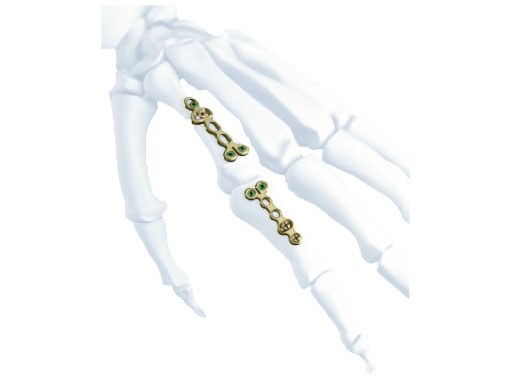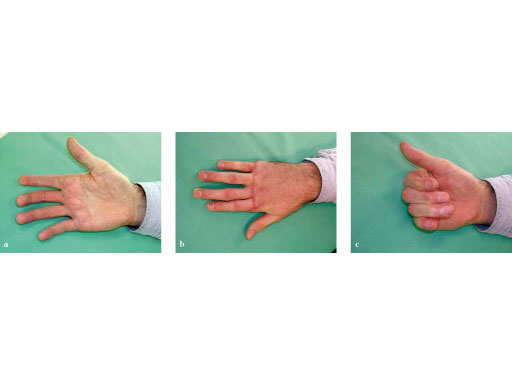
LCP Rotation Correction Plate 2.0
Fractures of the metacarpals and proximal phalanges which heal in malposition can lead to severe impairment of hand function. In particular, rotational misalignments are problematic because of crossing and scissoring digits whenever full flexion of the fingers to a fist is attempted. Optimal recovery of hand function includes the meticulous restoration of alignment, length and rotation of digits and metacarpals. A careful approach needs to be chosen in order not to further compromise the soft-tissue situation which again requires proper reconstruction. The fixation has to be stable enough to facilitate immediate active and passive finger exercises.
The LCP rotation correction plate 2.0 enables intraoperative correction of malrotation, adjustment to the bone and restoration of correct alignment, prevents scissoring of the digits, and is easily adaptable to condylar-near fractures.
The LCP rotation correction plate 2.0 is anatomically precontoured, has a low plate-and screw profile, rounded edges and polished surfaces which minimize irritation of soft tissue and ligaments. The plate features a 2.5?mm slotted hole in the medial lateral direction. This oblong hole, positioned transversally to the shafts axis, enables intraoperative verification of the result of the reduction and, where required, intraoperative correction of the rotational axis of the bone. The optimal posture of the digit can be set through loosening and tightening of the cortex screw in the transverse hole.
The plate is available in shaft lengths of 34?mm (3 combination holes) or 40?mm (4 holes) which allows fragment-specific treatment of metacarpal fractures and fractures of the proximal phalanges. Both versions are 1.3?mm thick, and available in stainless steel and CP titanium, as well as sterile and nonsterile.
30-year-old male, work accident with buzz-saw.
Fig 1ad: Preservation of the short base of the proximal phalanx for the extremly important flexion of the metacarpophalangeal (MP) joint.
Fig 2af: Primary treatment of the index fingers phalangeal fracture using the compact hand set 1.5.
Afterwards angular stable fixation at the very small MP-joint fragment of the middle fingers proximal phalanx, and precise adjustment of rotation with LCP rotation correction plate 2.0.
Fig 3ac: Full motion recovery 4 months postoperative.
Case provided by Martin Langer, Mnster, DE
Hazards and labeling
Due to varying countries’ legal and regulatory approval requirements, consult the appropriate local product labeling for approved intended use of the products described on this website. All devices on this website are approved by the AO Technical Commission. For logistical reasons, these devices may not be available in all countries worldwide at the date of publication.
Legal restrictions
This work was produced by AO Foundation, Switzerland. All rights reserved by AO Foundation. This publication, including all parts thereof, is legally protected by copyright.
Any use, exploitation or commercialization outside the narrow limits set forth by copyright legislation and the restrictions on use laid out below, without the publisher‘s consent, is illegal and liable to prosecution. This applies in particular to photostat reproduction, copying, scanning or duplication of any kind, translation, preparation of microfilms, electronic data processing, and storage such as making this publication available on Intranet or Internet.
Some of the products, names, instruments, treatments, logos, designs, etc referred to in this publication are also protected by patents, trademarks or by other intellectual property protection laws (eg, “AO” and the AO logo are subject to trademark applications/registrations) even though specific reference to this fact is not always made in the text. Therefore, the appearance of a name, instrument, etc without designation as proprietary is not to be construed as a representation by the publisher that it is in the public domain.
Restrictions on use: The rightful owner of an authorized copy of this work may use it for educational and research purposes only. Single images or illustrations may be copied for research or educational purposes only. The images or illustrations may not be altered in any way and need to carry the following statement of origin “Copyright by AO Foundation, Switzerland”.
Check www.aofoundation.org/disclaimer for more information.
If you have any comments or questions on the articles or the new devices, please do not hesitate to contact us.
“approved by AO Technical Commission” and “approved by AO”
The brands and labels “approved by AO Technical Commission” and “approved by AO”, particularly "AO" and the AO logo, are AO Foundation's intellectual property and subject to trademark applications and registrations, respectively. The use of these brands and labels is regulated by licensing agreements between AO Foundation and the producers of innovation products obliged to use such labels to declare the products as AO Technical Commission or AO Foundation approved solutions. Any unauthorized or inadequate use of these trademarks may be subject to legal action.
AO ITC Innovations Magazine
Find all issues of the AO ITC Innovations Magazine for download here.
Innovation Awards
Recognizing outstanding achievements in development and fostering excellence in surgical innovation.








